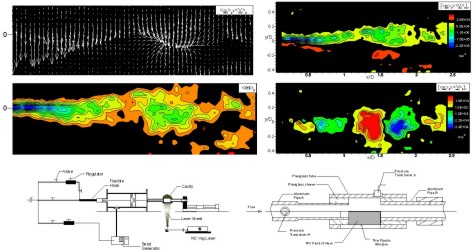Imaging of the Self-Excited Oscillation of Flow Past a Shallow Cavity During Generation of a Flow Tone
Peter Oshkai
> Research >
Recent and Ongoing Investigations
Department of Mechanical Engineering > University of Victoria
 Imaging of the Self-Excited Oscillation of Flow Past a Shallow Cavity During Generation of a Flow Tone.
Flow through a pipeline-cavity system can give rise to pronounced flow tones, even when the inflow boundary layer is fully turbulent. Such tones arise from the coupling between the inherent instability of the shear flow past the cavity and a resonant acoustic mode of the system. A technique of high-image-density particle image velocimetry is employed in conjunction with a special test section, which allows effective laser illumination and digital acquisition of patterns of particle images. This approach leads to patterns of velocity, vorticity, streamline topology and hydrodynamic contributions to the acoustic power integral.
Imaging of the Self-Excited Oscillation of Flow Past a Shallow Cavity During Generation of a Flow Tone.
Flow through a pipeline-cavity system can give rise to pronounced flow tones, even when the inflow boundary layer is fully turbulent. Such tones arise from the coupling between the inherent instability of the shear flow past the cavity and a resonant acoustic mode of the system. A technique of high-image-density particle image velocimetry is employed in conjunction with a special test section, which allows effective laser illumination and digital acquisition of patterns of particle images. This approach leads to patterns of velocity, vorticity, streamline topology and hydrodynamic contributions to the acoustic power integral.
The top left image shows vectors w×V for a given phase of the oscillation cycle. For purposes of comparison, the corresponding pattern of phase-averaged vorticity <w>p is illustrated immediately beneath this image. The image of w×V shows relatively large vertical, downward-oriented vectors, which are primarily due to the high values of w immediately downstream of the leading-corner of the cavity. With increasing streamwise distance, the magnitudes of these vectors decrease somewhat until, at the location of the large-scale cluster of vorticity, significant vertical and horizontal vectors of opposing signs are clearly evident.
The top right image shows the transverse projections of the phase-averaged hydrodynamic contribution to the acoustic power integral shown in the top left image. As shown in the left column, the agglomeration of vorticity leads to a clearly defined, distinct cluster of vorticity at larger streamwise distances. This agglomeration results in regions of larger spatial extent of high levels of [<w>p×<V>p]y. Correspondingly, the bottom right image shows the streamwise projection of the hydrodynamic contribution [<w>p×<V>p]x. In this case, the effect of the increased agglomeration of vorticity is even more evident, as the spatial extent of large values of [<w>p×<V>p]x increases at larger values of streamwise distance along the cavity.
M. Geveci, P. Oshkai, D. Rockwell, J.-C. Lin, and M. Pollack.
Click here for reference and abstract
poshkai@me.uvic.ca
 Imaging of the Self-Excited Oscillation of Flow Past a Shallow Cavity During Generation of a Flow Tone.
Flow through a pipeline-cavity system can give rise to pronounced flow tones, even when the inflow boundary layer is fully turbulent. Such tones arise from the coupling between the inherent instability of the shear flow past the cavity and a resonant acoustic mode of the system. A technique of high-image-density particle image velocimetry is employed in conjunction with a special test section, which allows effective laser illumination and digital acquisition of patterns of particle images. This approach leads to patterns of velocity, vorticity, streamline topology and hydrodynamic contributions to the acoustic power integral.
Imaging of the Self-Excited Oscillation of Flow Past a Shallow Cavity During Generation of a Flow Tone.
Flow through a pipeline-cavity system can give rise to pronounced flow tones, even when the inflow boundary layer is fully turbulent. Such tones arise from the coupling between the inherent instability of the shear flow past the cavity and a resonant acoustic mode of the system. A technique of high-image-density particle image velocimetry is employed in conjunction with a special test section, which allows effective laser illumination and digital acquisition of patterns of particle images. This approach leads to patterns of velocity, vorticity, streamline topology and hydrodynamic contributions to the acoustic power integral.